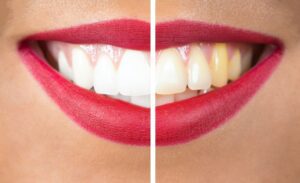Having a bright and radiant smile is something that many people desire. However, sometimes despite proper oral hygiene, our teeth still get stained or discolored. Chemical whitening treatments have become a popular solution for this problem, but there are certain types of tooth stains that these treatments cannot alter.
Anything from dental trauma to genetics can minimize the effectiveness of chemical whitening treatments. As a result, you may need an alternative treatment to get a brighter, whiter smile.

What Stains Are Difficult to Treat?
Intrinsic stains occur deep within the tooth’s enamel or dentin and cannot be removed by surface-level treatments like chemical whitening. A variety of factors can contribute to these types of stains, including genetics, certain medications, or excessive fluoride exposure during tooth development. Intrinsic stains can also occur during dental procedures if there is trauma to the tooth or root canal procedures.
Medication
Although medication that a doctor prescribes for a medical issue is necessary, sometimes it has unfortunate side effects. For example, tetracycline is an antibiotic that a doctor can use for bacterial infections. Unfortunately, it can also cause significant tooth discoloration when taken during childhood when teeth are developing. This antibiotic can cause permanent yellow, brown, or even gray discoloration in the enamel.
Aging
As we age, our teeth naturally become more yellow or brown due to changes in the tooth’s structure and composition. With years of use, the enamel becomes thinner as the structure of the tooth wears down. Additionally, the dentin beneath the enamel becomes darker, making it easier to see through the thin enamel.
Dental Trauma
Trauma to the tooth, such as a fall or a blow to the face, can cause the tooth to turn gray or even black. This type of stain occurs when the pulp inside the tooth dies, causing blood and other fluids to seep into the tooth’s structure. Unfortunately, chemical whitening cannot penetrate deep enough to remove these types of stains. Therefore, you will have to try an alternative option.
Potential Treatment Options
A popular, non-invasive whitening treatment is tooth bonding. Tooth bonding is a process where your dentist uses a composite resin to cover the surface of your teeth. Rather than breaking the stain down, tooth bonding camouflages any discoloration. In one session, you can have a brighter, whiter smile.
Another potential treatment option for stubborn discoloration is porcelain veneers. Unlike tooth bonding, your dentist will place a thin porcelain shell on the surface of your teeth. For proper placement, your dentist will need to remove a small portion of the enamel to ensure a natural look and feel. Porcelain veneers can provide a more durable, whiter smile.
Finally, you can ask your dentist about dental crowns to correct severe discoloration. A dental crown is like a “cap” for your tooth. Like a porcelain veneer, your dentist will need to remove some of the tooth’s structure for proper placement. Dental crowns can cover permanent stains to improve your smile drastically.
